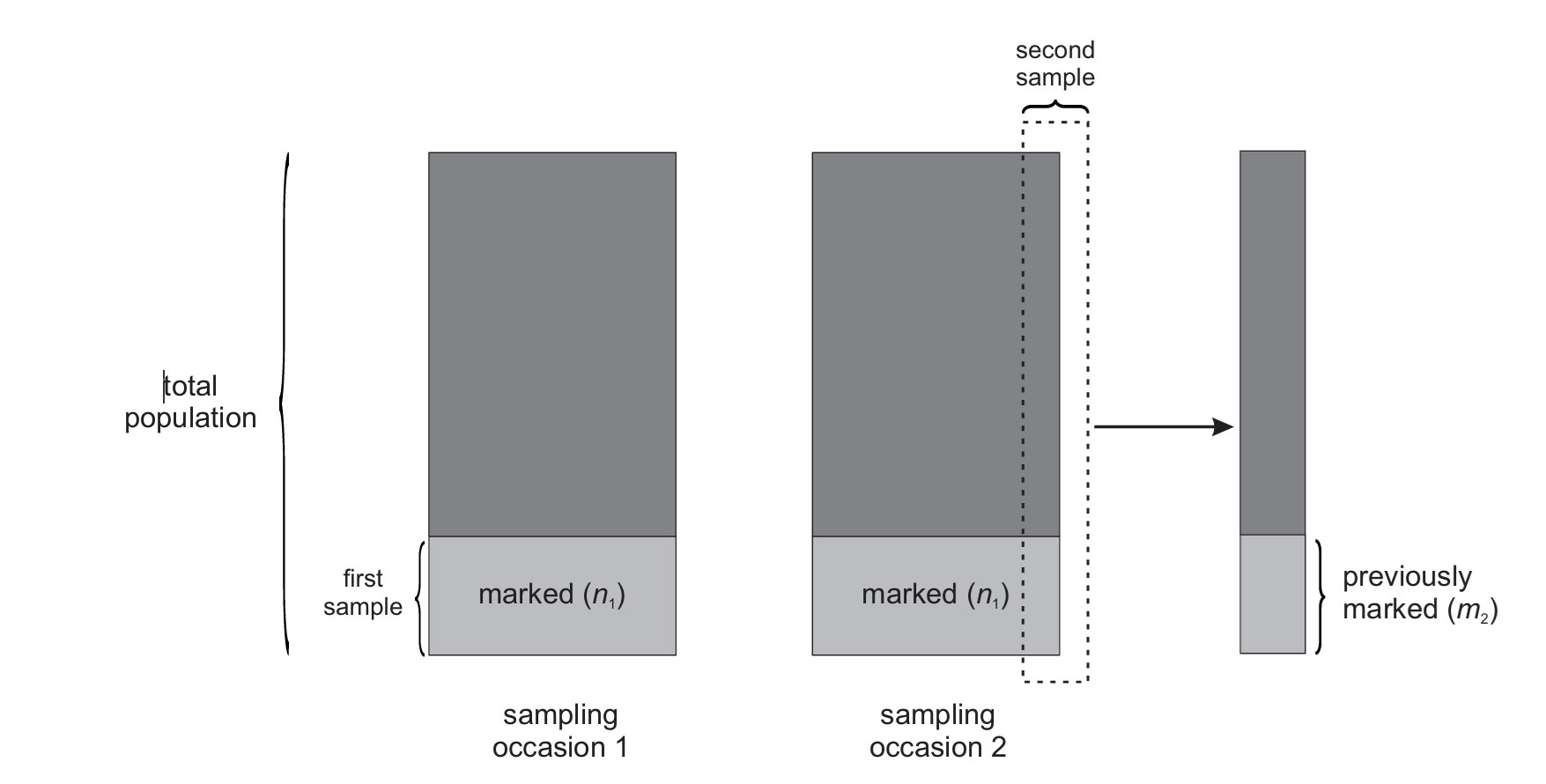| Indiv | height | weight |
|---|---|---|
| 1 | 32 | 25 |
| 2 | 24 | 20 |
| 3 | 28 | 26 |
| 4 | 20 | 13 |
| 5 | 36 | 33 |
| 6 | 25 | 26 |
Ratio Estimation
(precise auxillary information)
Auxillary Information
- stratification used coarse aux. information to improve estimator precision
- groupings
- Can we use continuous aux. information?
- Ratio Estimator
Fundamental Information
- We sample via probabilistic sampling and observe our primary variable of interest (\(y_i\))
- We also record a secondary variable - that correlates with the primary (\(x_i\))
- We also know the true population mean/total for the secondary variable (\(\mu_x\))
Is this useful to us??
Relevant Wildlife/Fish/Habitat studies???
Example
We take morphometric data on all Lowland Tree Kangaroos in a forest of Papua New Guinea (6 individuals).
However, what if you end up releasing 2 individuals before getting their weight, but all individuals height was measured.

What was the mean weight of all individuals in the forest?
Example (truth)

\(\mu_{weight} =\) 23.8333333
\(\mu_{height} =\) 27.5
Example (samples)
Weight
| Sample.Number | Indiv.1 | Indiv.2 | Indiv.3 | Indiv.4 | means |
|---|---|---|---|---|---|
| 1 | 25 | 25 | 25 | 25 | 25.00 |
| 2 | 25 | 25 | 25 | 25 | 25.00 |
| 3 | 25 | 25 | 20 | 20 | 22.50 |
| 4 | 20 | 20 | 26 | 20 | 21.50 |
| 5 | 20 | 20 | 20 | 20 | 20.00 |
| 6 | 20 | 26 | 26 | 26 | 24.50 |
| 7 | 13 | 26 | 26 | 26 | 22.75 |
| 8 | 13 | 13 | 26 | 26 | 19.50 |
| 9 | 26 | 13 | 13 | 33 | 21.25 |
| 10 | 13 | 13 | 33 | 33 | 23.00 |
| 11 | 13 | 13 | 33 | 33 | 23.00 |
| 12 | 33 | 13 | 33 | 26 | 26.25 |
| 13 | 33 | 26 | 26 | 33 | 29.50 |
| 14 | 26 | 26 | 26 | 33 | 27.75 |
| 15 | 26 | 26 | 26 | 26 | 26.00 |
\(E[\hat{\mu}_{weight}] =\) 23.8333333 \(=\mu_{weight}\)
\(E[\hat{\sigma}^2] = 3.3777\)
Example (samples)
Height
| Sample.Number | Indiv.1 | Indiv.2 | Indiv.3 | Indiv.4 | means |
|---|---|---|---|---|---|
| 1 | 32 | 32 | 32 | 32 | 32.00 |
| 2 | 32 | 32 | 32 | 32 | 32.00 |
| 3 | 32 | 32 | 24 | 24 | 28.00 |
| 4 | 24 | 24 | 28 | 24 | 25.00 |
| 5 | 24 | 24 | 24 | 24 | 24.00 |
| 6 | 24 | 28 | 28 | 28 | 27.00 |
| 7 | 20 | 28 | 28 | 28 | 26.00 |
| 8 | 20 | 20 | 28 | 28 | 24.00 |
| 9 | 28 | 20 | 20 | 36 | 26.00 |
| 10 | 20 | 20 | 36 | 36 | 28.00 |
| 11 | 20 | 20 | 36 | 36 | 28.00 |
| 12 | 36 | 20 | 36 | 25 | 29.25 |
| 13 | 36 | 25 | 25 | 36 | 30.50 |
| 14 | 25 | 25 | 25 | 36 | 27.75 |
| 15 | 25 | 25 | 25 | 25 | 25.00 |
\(E[\hat{\mu}_{height}] =\) 27.5 \(=\mu_{height}\)
Ratio Estimator of population mean
\(\hat{\mu}_{r}\) = sample ratio \(\times\) population mean of aux
\(\hat{\mu}_{r}\) = sample primary mean / sample aux. mean \(\times\) population mean of aux . . .
\(\hat{\mu}_{r}\) = \(r \times \mu_{x}\)
\(\mu_{x} = \frac{\sum_{i=1}^N x_i}{N}\)
\(\hat{r} = \frac{\sum_{i=1}^n y_i}{\sum_{i=1}^n x_i} = \frac{\hat{\mu}_{primary}}{\hat{\mu}_{secondary}} =\frac{\hat{\mu}_{weight}}{\hat{\mu}_{height}}= \frac{\bar{y}}{\bar{x}}\)
Ratio Estimator of population mean
\[ \hat{\sigma}^2_{\hat{\mu_r}} = \left(\frac{N-n}{N}\right)\frac{\hat{\sigma}^2_r}{n} \]
\[ \hat{\sigma}^2_r = \frac{1}{n-1}\sum_{i=1}^n\left(y_i-rx_i\right)^2 \]
Example (ratio estimator)
| Sample.Number | Primary.Weight | Aux.Height | Ratio |
|---|---|---|---|
| 1 | 32.00 | 25.00 | 21.48438 |
| 2 | 32.00 | 25.00 | 21.48438 |
| 3 | 28.00 | 22.50 | 22.09821 |
| 4 | 25.00 | 21.50 | 23.65000 |
| 5 | 24.00 | 20.00 | 22.91667 |
| 6 | 27.00 | 24.50 | 24.95370 |
| 7 | 26.00 | 22.75 | 24.06250 |
| 8 | 24.00 | 19.50 | 22.34375 |
| 9 | 26.00 | 21.25 | 22.47596 |
| 10 | 28.00 | 23.00 | 22.58929 |
| 11 | 28.00 | 23.00 | 22.58929 |
| 12 | 29.25 | 26.25 | 24.67949 |
| 13 | 30.50 | 29.50 | 26.59836 |
| 14 | 27.75 | 27.75 | 27.50000 |
| 15 | 25.00 | 26.00 | 28.60000 |
\(E[\hat{\mu}_{r}] =\) 23.8683977 \(\neq\) 23.83333
\(E[\hat{\sigma^2}] = 0.523\) (3.37 using Sample Average Estimator)
Comparisons
- Sample average of primary (weight) is unbiased
- min: 19.5
- max: 29.5
- Exp.Var: 3.3777778
- Ratio estimator of primary (weight) is biased
- min: 21.484375
- max: 28.6
- Exp.Var: 0.5236118
Considerations
Ratio Estimator
- design based
- estimators are not unbiased (almost at large sample size; Thompson, Ch. 7)
- improves precision
- depends on linear correlation b/w primary and auxiliary information
- requires: when \(x_i = 0\) then \(y_i=0\); i.e., intercept is zero
- rarely do we measure one thing when sampling
Classic Example
Pierre-Simon Laplace
- Wanted a census of France in 1802
- Primary: Population Size
- Auxiliary: Births
- Had all birth records from church records
- Sampled 30 communities and calculated a total of 2,037,615 people with 71,866 births
- 2,037,615/71,866 = 28.35 people per birth
- Reasoned he could multiply the population number of births by 28.35 to obtain an estimate of population size.
Classic Wildlife Example
Estimating total population
- We mark and release \(n_1\) individuals
- We go and recapture the same population, catching \(n_2\) individuals
- The number of marked individuals caught again is \(m_2\)
- Assume equal catchability of individuals and by sample
Classic Wildlife Example
Estimating total population
\[ \frac{m_2}{n_2} = \frac{n_1}{N} \]
Lincoln-Peterson Abundance Estimator
Classic Wildlife Example
\[ \hat{N} = \frac{n_1n_2}{m_2} \]
\[ \hat{N} = \frac{n_1}{\hat{p}} \]
\[ \hat{p} = \frac{m_2}{n_2} \]
Classic Wildlife Example

Model-based Ratio Estimators
\[ \begin{align*} y_{i} &= \beta_0 + \beta_1 \times x_{i} + e_{i}\\ \epsilon_{i} &\sim \text{Normal}(0, \sigma) \end{align*} \]
\[ \begin{align*} E[y_{i}] &= \beta_0 + \beta_1 \times x_{i} \end{align*} \]
Model-based Ratio Estimators
Thompson, Section 8.3:
“Like the ratio estimator, the regression estimator is not unbiased in the design sense under simple random sampling.”
“That is, viewing the y and x values as fixed quantities, the expected value, over all possible samples, of the regression estimator of the population mean of the y’s does not exactly equal the true population mean.”
Unbiasedness Evaluation
Unbiasedness Evaluation

Estimators
\[
\begin{align*}
\hat{\mu} =& a + b\times\mu_x\\
\hat{\mu}_{y} =& \beta_0 + \beta_1\times\mu_x
\end{align*}
\]
Thompson, Section 8.1 (ordinary least squares)
\[ \begin{align*} \beta_1 =& \frac{\sum_{i=1}^{n}(x_i-\bar{x})\times(y_i-\bar{y})}{\sum_{i=1}^n(x_i-\bar{x})^2}\\ \beta_0 =& \bar{y}-\beta_1\times\bar{x} \end{align*} \]
Unbiasedness Evaluation
nsim = 10000
pred.model.coef = beta1.save = save.mean=rep(NA, nsim)
for(i in 1:nsim){
# Sample size
n = 100
#simple random sample
index = sample(1:N,n)
#Eqns in Section 8.1
beta1.save[i] = sum((x[index]-mean(x[index]))*(y[index]-mean(y[index])))/sum((x[index]-mean(x[index]))^2)
beta0 = mean(y[index]) - beta1.save[i] * mean(x[index])
save.mean[i] = beta0 + beta1.save[i]*mean(x)
pred.model.coef[i] = coef(lm(y[index]~x[index]))[2]
}Unbiasedness Evaluation
Slope Estimator

Unbiasedness Evaluation
Slope Model

Unbiasedness Evaluation
Population Average

Unbiasedness Evaluation
Slope estimates are not unbiased. Not Design-Unbiased!
What about model-unbiased?
Model Unbiasedness Evaluation
nsim=10000
pred.model.coef= beta1.save = save.mean=rep(NA, nsim)
N = 500
set.seed(453543)
x = rpois(N, 500)
# Fixed
beta0 = -5
beta1 = 4
sigma = 100
for(i in 1:nsim){
# True is now changing!
epsilon = rnorm(N, 0, sigma)
y = beta0 + beta1*x + epsilon
# Sample size
n = 100
# simple random sample
index=sample(1:N,n)
# Eqns in Section 8.1
beta1.save[i] = sum((x[index]-mean(x[index]))*(y[index]-mean(y[index])))/sum((x[index]-mean(x[index]))^2)
beta0 = mean(y[index]) - beta1.save[i] * mean(x[index])
save.mean[i] = beta0 + beta1.save[i]*mean(x)
pred.model.coef[i]=coef(lm(y[index]~x[index]))[2]
}Model Unbiasedness Evaluation
Slope Estimator
[1] 0.0002540056
Unbiasedness
“Design unbiased” refers to estimators that are unconditionally unbiased regardless of the underlying model; a very strong assertion!
Some estimators, including Ordinary Least Squares (OLS) may be model unbiased but not design-unbiased.
Unbiasedness
OLS unbiasedness is a property of the estimator for a specific model (super population! the world is not fixed)
Design unbiasedness is a property of the estimator with respect to the design of the sampling, making it model-independent